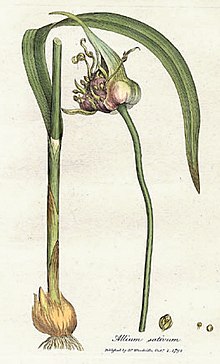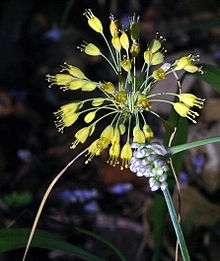| Allium | |
|---|---|

| |
| Allium sativum[2] | |
| Scientific classification | |
| Kingdom: | Plantae |
| Clade: | Tracheophytes |
| Clade: | Angiosperms |
| Clade: | Monocots |
| Order: | Asparagales |
| Family: | Amaryllidaceae |
| Subfamily: | Allioideae |
| Tribe: | Allieae |
| Genus: | Allium L. |
| Type species | |
| Allium sativum | |
| Evolutionary lines | |
| Synonyms[3] | |
|
Synonymy
| |

Allium is a genus of monocotyledonous flowering plants with hundreds of species, including the cultivated onion, garlic, scallion, shallot, leek, and chives. It is one of about 57 genera of flowering plants with more than 500 species.[4] It is by far the largest genus in the Amaryllidaceae, and also in the Alliaceae in classification systems in which that family is recognized as separate.[5]
Allium species occur in temperate climates of the Northern Hemisphere, except for a few species occurring in Chile (such as A. juncifolium), Brazil (A. sellovianum), and tropical Africa (A. spathaceum). They vary in height between 5–150 centimetres (2–59 in). The flowers form an umbel at the top of a leafless stalk. The bulbs vary in size between species, from small (around 2–3 mm in diameter) to rather large (8–10 cm). Some species (such as Welsh onion A. fistulosum and leeks (A. ampeloprasum)) develop thickened leaf-bases rather than forming bulbs as such.
Carl Linnaeus first described the genus Allium in 1753. The generic name Allium is the Latin word for garlic,[6][7] and the type species for the genus is Allium sativum which means "cultivated garlic".[8] The decision to include a species in the genus Allium is taxonomically difficult, and species boundaries are unclear. Estimates of the number of species are as low as 260,[5] and as high as 979.[9] In the APG III classification system, Allium is placed in the family Amaryllidaceae, subfamily Allioideae (formerly the family Alliaceae).[10] In some of the older classification systems, Allium was placed in Liliaceae.[11][12][13][14][15] Molecular phylogenetic studies have shown this circumscription of Liliaceae is not monophyletic.
Various Allium have been cultivated from the earliest times, and about a dozen species are economically important as crops, or garden vegetables, and an increasing number of species are important as ornamental plants.[11][12] Plants of the genus produce chemical compounds, mostly derived from cysteine sulfoxides, that give them a characteristic onion or garlic taste and odor.[11] Many are used as food plants, though not all members of the genus are equally flavorful. In most cases, both bulb and leaves are edible. The characteristic Allium flavor depends on the sulfate content of the soil the plant grows in.[11] In the rare occurrence of sulfur-free growth conditions, all Allium species completely lose their usual pungency.
- ^ Cite error: The named reference
Linnaeuswas invoked but never defined (see the help page). - ^ "1793 illustration from William Woodville: "Medical botany", London, James Phillips, 1793, Vol. 3, Plate 168: Allium sativum (Garlic). Hand-coloured engraving". Archived from the original on 2011-02-17. Retrieved 2015-04-07.
- ^ Kew World Checklist of Selected Plant Families
- ^ Frodin, David G. (2004). "History and concepts of big plant genera". Taxon. 53 (3): 753–776. doi:10.2307/4135449. JSTOR 4135449.
- ^ a b Knud Rahn. 1998. "Alliaceae" pages 70-78. In: Klaus Kubitzki (editor). The Families and Genera of Vascular Plants volume III. Springer-Verlag: Berlin;Heidelberg, Germany. ISBN 978-3-540-64060-8
- ^ Quattrocchi 1999, vol. 1 p. 91.
- ^ Gledhill, David (2008). "The Names of Plants". Cambridge University Press. ISBN 9780521866453 (hardback), ISBN 9780521685535 (paperback). pp 43
- ^ Allium In: Index Nominum Genericorum. In: Regnum Vegetabile (see § External links below).
- ^ The Plant List, for genus Allium
- ^ Chase, M.W.; Reveal, J.L. & Fay, M.F. (2009). "A subfamilial classification for the expanded asparagalean families Amaryllidaceae, Asparagaceae and Xanthorrhoeaceae". Botanical Journal of the Linnean Society. 161 (2): 132–136. doi:10.1111/j.1095-8339.2009.00999.x.
- ^ a b c d Eric Block (2010). Garlic and Other Alliums: The Lore and the Science. Royal Society of Chemistry. ISBN 978-0-85404-190-9.
- ^ a b Dilys Davies (1992). Alliums: The Ornamental Onions. Timber Press. ISBN 978-0-88192-241-7.
- ^ James L. Brewster, "Onions and Other Alliums" (Wallingford: CABI Publishing, 2008)
- ^ Haim D. Rabinowitch, Leslie Currah, "Allium Crop Sciences: Recent Advances" (Wallingford: CABI Publishing, 2002)
- ^ Penny Woodward, "Garlic and Friends: The History, Growth and Use of Edible Alliums" (South Melbourne: Hyland House, 1996)